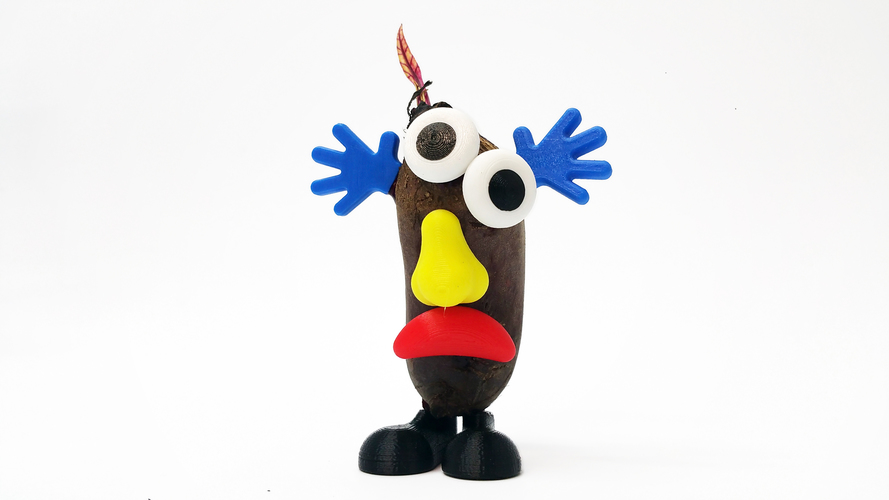
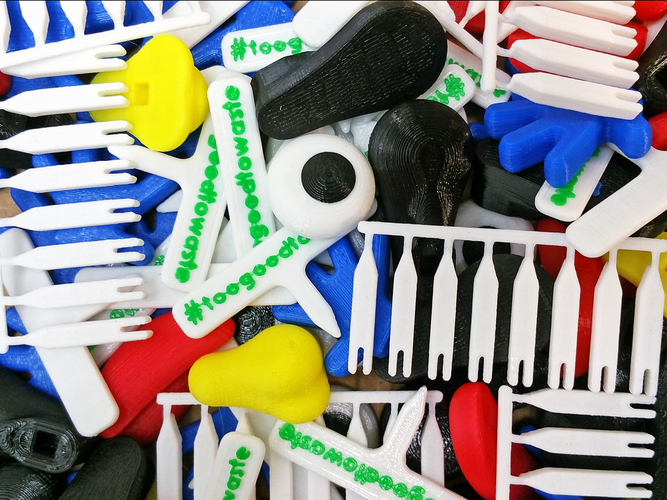

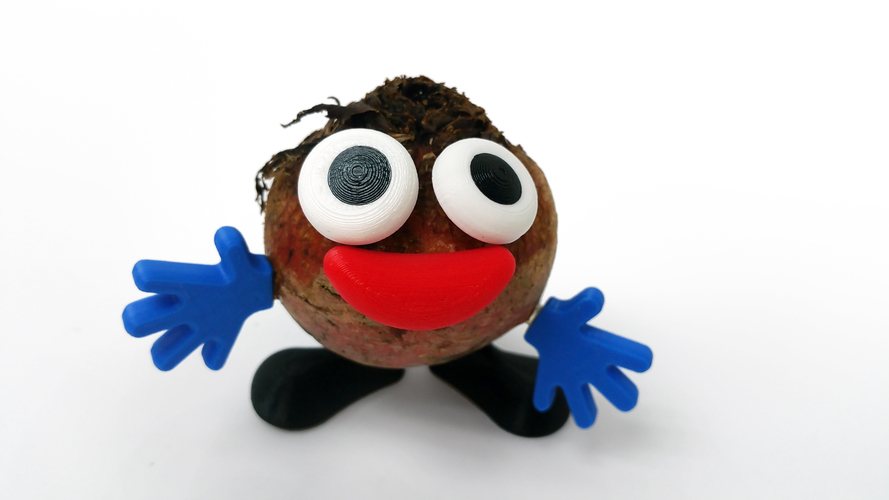
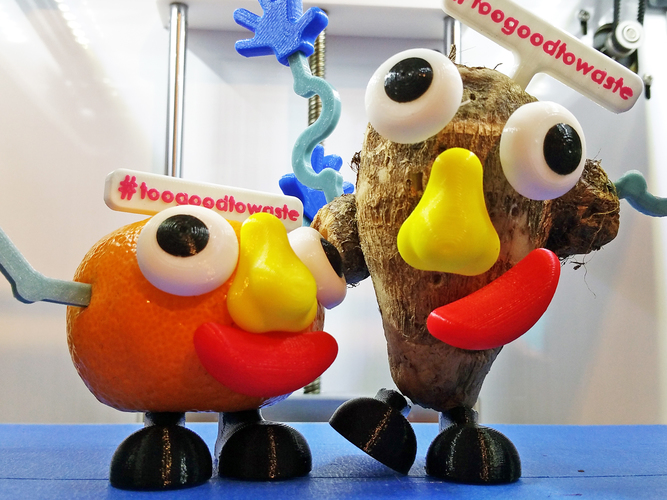
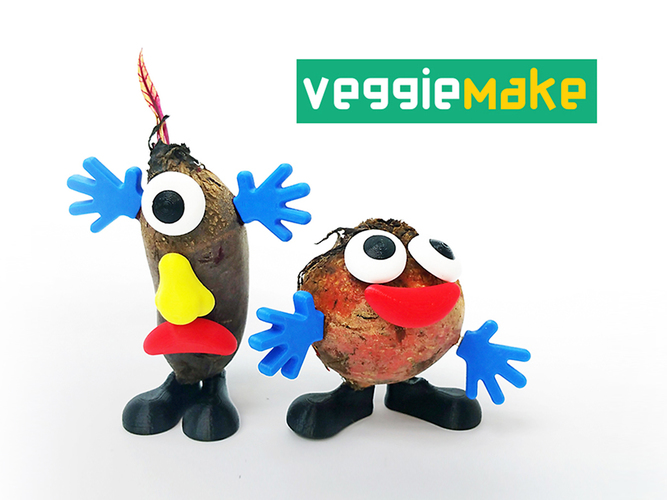
Prints (0)
-
No Prints Yet
Be the first to upload a Print for this Design!
Description
Students are given a VeggieMake (a toy that turns produce into a cute character)– but the pieces don’t attach to the produce. Therefore, students will have to design pins. This works well because it is an easy project with minimal emotional investment plus the small pins are fast to print and students can make changes quickly. It reinforces the idea that 3D printing is useful for quick prototyping and creative iterations.
The VeggieMake also encourages students to use ugly fruits and vegetables.
VeggieMake was designed as a teaching tool to introduce 3D printing and 3D design. We designed the parts with three things in mind: the parts needed to be easily 3D printable by any printer, they needed to be printable without support structure, and they needed to be quick prints so that multiple students could share in “VeggieMaking” with a single 3D printer. We used SolidWorks to design the VeggieMake features (eyes, nose, mouth, feet, and hands). These parts were designed using advanced 3D modeling techniques, and are not intended to be changed by introductory students. We designed the VeggieMake pins using Tinkercad. We chose to use Tinkercad because we feel it is the best platform for learning introductory 3D design. The pins were designed using a box stretched to become a long square, then adding a roof on its side to become a sharp point to insert into the produce. One trick that we used on the pin design was to cut a small slit on the end of the piece that inserts into the VeggieMake features. This small slit is helpful to add some flexibility to the pins so that they will be a nice snug fit in the features. Search “VeggieMake” on Tinkercad to download our adaptable design and create your own pins! Note: we've provided pins in the files but you should start the lesson plan with no pins available.
Overview & Background
3D printing technology is best used for prototyping ideas but we have observed that many students want to design the perfect piece for 3D printing. We’ve designed an exercise that is fun but reinforces the idea that ‘failing fast’ works to improve your ideas.
Lesson/Activity Plan
Introduction Introduce the idea of iterative design and prototyping. Although it is tempting to ‘just do it once’, it is difficult to accomplish your best work on the first try. Design, like learning, requires use to re-work our ideas. It is important for teachers to provide feedback to students throughout the process. The VeggieMake encourages students to use ugly fruit and vegetables.
What To Do Have one person from each pair (or group of 3) choose an ugly fruit for their creation Hand out one set of VeggieMake parts to each pair (or group of 3) and ask them to start making creatures. They will quickly determine that they can’t attach the pieces. Explain that each group will need to design a pin that will attach the pieces to the produce. (If don’t do the measure extension) Explain that the holes are designed to be 4 mm x 4 mm but due to imperfections with 3D printing , there will be variation in the hole size. Have the students draw ideas for a pin. Encourage them to do more than one type. Depending on the age group, insist that the pen and paper design include measurements. Introduce TinkerCad: Students can work through the tutorials available Shortcut: 1. show the students how to drag and drop a square and then change dimensions. 2. Add a triangle and group it with the square to make a ‘house’. 3. Can add a hole to create a door in your house. Students start creating! As students finish their designs, they download them as STL files. Explain how to slice the designs so they are ready for 3D printing. This is a good time to discuss how 3D printing is a layering technology. (If you need to save time, you can do the introduction of 3D printing before Tinkercad and have all the slicing done by teacher.) The first designs should be sliced at 300 nm (coarse) to make printing faster. Print first version of student designs. Only do one pin until the students have shown that their design works in more than one VeggieMake piece. These prints should be fast (less than 4 min) but it is a good time to break if needed. Students try out their design and make changes if needed. Encourage them to keep optimizing their design. Once students know their pins will work in more than one VeggieMake piece (to account for 3D printing variability of holes), they can print 8 copies at a finer slicing (200 mm works well). This is also a good place to break and provide the set of pins to students at a later time. Note: give students a chance to watch the 3D printing of their work.
Key Questions How does 3D printing work? Why didn’t my design work on the first try?
Duration One hour is sufficient for basic activity and it can be broken across several classes (e.g. design on paper could be homework). If add in optional activities like precise measurement and/or new pieces, can be 2 to 3 hours.
Materials:
Skills Learned (Standards)
- 3D design
- 3D printing layering
- prototyping
- scientific process (trial, assess, modify)
Preparation
Rubric/Assessment
Students design on paper could be marked for including all requirements (e.g. measurements). Students can also keep a notebook to describe their design process and how they changed their design based on previous iterations.
VeggieMake is also a great tool to highlight the issues of food waste and food production.
Delicious and nutritious VeggieMake candidates are thrown out every day. Did you know:
Each year 2.9 trillion pounds of food never gets consumed.
That’s about 1/3rd of all the food produced in the world and enough to feed 2 billion people.
Of the food in our homes, fruits and vegetables are usually the first to be tossed out.
Consuming ugly food can help reduce food waste, and help to protect the planet.
Head to your local produce store and stop this madness... Choose ugly or old produce and get VeggieMaking!
VeggieMake is #toogoodtowaste and a ton of fun!
Comments